By Anthony G. Williams
Combat experience in Afghanistan has prompted some rapid changes in the small arms carried by ISAF foot soldiers; and most especially by the U.S. Army, USMC and the British Army and Royal Marines. The purpose of this article is to outline these changes, determine the lessons learned, and look ahead to examine the extent to which the growing variety of rifles including DMRs (Designated Marksman Rifles), carbines, IARs (Infantry Automatic Rifles) and LMGs (light machine guns) might be replaced in the future by a smaller number of weapons without losing any capability.
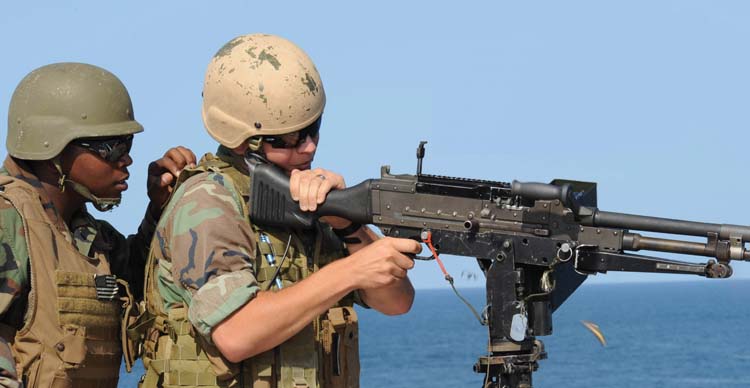
Developments to Date
Before the Afghan conflict began, it was assumed that most small-arms engagements would continue to take place within the traditional 300 meter limit, as they had in Iraq, and ISAF forces were equipped accordingly. The rifles and LMGs carried by the infantry on foot patrols were overwhelmingly in the relatively short-range 5.56mm caliber, using the NATO standard SS109/M855 ammunition. The U.S. forces used three principal weapons: the M16 rifle (favoured by the USMC), short-barrelled M4 Carbine (favoured by the U.S. Army because its compactness makes it more suitable for urban fighting, the typical scenario in Iraq) and the M249 development of the FN Minimi LMG. Some long-range weapons in 7.62×51 NATO caliber, most notably the M240 GPMG (FN MAG variant) and also some sniper rifles and DMRs, were available for use in a support role when required. The British patrols used the 5.56mm L85A2 rifle, L86A2 Light Support Weapon (effectively an IAR) and the L110 LMG (FN Minimi Para). The L85A2 and L86A2 are the principal members of the SA80 family, which has had a controversial history. As with the U.S. forces, the 7.62mm L7 GPMG (FN MAG) was available in support, and bolt-action 7.62mm sniper rifles were also in service.
These arrangements were thrown into disarray when faced with the very different circumstances of Afghanistan, where the Taliban noted the range limitation of the 5.56mm weapons and, wherever circumstances permitted, opted to engage ISAF troops from longer distances. They could do this because as well as the ubiquitous but short-ranged AK family of assault rifles in 7.62×39 caliber, they have weapons chambered in the powerful Russian 7.62x54R round, equivalent in performance to the NATO 7.62×51. The principal weapons using this cartridge are the lightweight PKM belt-fed LMG and the SVD semiautomatic sniper rifle. Both the U.S. and British forces have reported that more than half of Taliban small-arms attacks are launched from ranges greater than 300 meters, out to as far as 900 meters. While the 5.56mm NATO weapons were previously claimed to be effective out to 450-600 meters, experience has shown that their performance falls off sharply beyond 300m – or even less, when used in short-barrelled weapons.
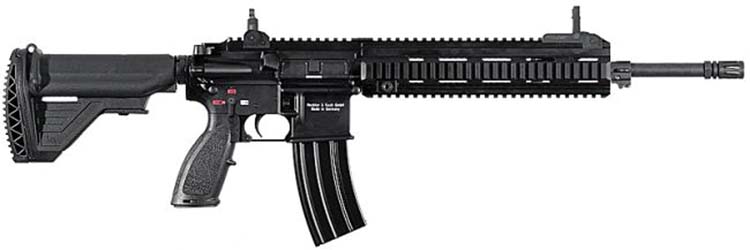
The adoption by U.S. forces of replacements for the M855, in the form of the M855A1 EPR (U.S. Army) and MK318 Mod 0 (USMC), should resolve some other problems with the existing 5.56mm ammunition concerning erratic terminal effectiveness and poor barrier penetration. However, these are unlikely to help the UK and other NATO nations whose lawyers tend to adopt a very literal interpretation of the Hague Convention prohibition of bullets “with a hard envelope which does not entirely cover the core” – which describes both of the new U.S. bullets. In any case, no 5.56mm developments could achieve enough of an improvement to eliminate the need for a larger caliber to cover the longer small-arms ranges.
The immediate – and indeed, only immediately available – response of the U.S. and UK forces was to redistribute existing 7.62mm weapons to the foot patrols, despite their unsuitability in terms of weight (FN MAG) or low rate of fire (bolt-action sniper rifles). The next stage was to launch urgent requirements for new 7.62mm weapons. In machine guns, both the USA and UK have been developing lightened versions of the FN MAG and also adopting new lightweight MGs, comparable in weight and performance to the Taliban’s PKM. The U.S. already has the MK48, the 7.62mm version of the FN Minimi which the British also selected in mid-2011.
New rifles have been acquired; the U.S. had the advantage of already having selected the 7.62mm M110 SASS (Semi-Automatic Sniper System) and has also refurbished some 5,000 of the old 7.62mm M14 rifles as the M14 EBR (Enhanced Battle Rifle) with modern furniture and accessories. These are proving very popular. The British have acquired a limited quantity of a 7.62mm self-loading sharpshooter rifle from the USA, the L129A1, which is also very popular. In contrast, the USMC has kept one eye on the needs of urban fighting and has rather controversially acquired a new, compact 5.56mm IAR to replace many of the M249s at section level; the HK 416-based M27.
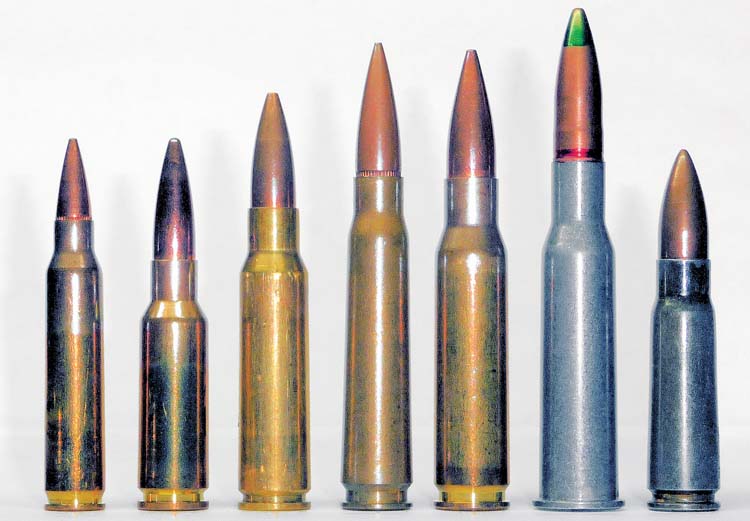

The Case for Change
So we now have the following rifles and MGs in service or in prospect, all intended to be carried by dismounted soldiers on patrol: In the USA, the 5.56mm M4, M16, M27 and M249, plus the 7.62mm M14EBR, M110, MK48 and lightweight M240. That’s a total of eight weapons, four in each caliber. In addition they have heavier support weapons and bolt-action sniper rifles, plus Special Forces use the MK12 5.56mm and the MK17 (FN SCAR-H) 7.62mm rifles.
The UK forces have the 5.56mm L85A2, L86A2 and L110, plus the 7.62mm L129A1, L7 GPMG, and 7.62mm FN Minimi: a total of six weapons, with three in each caliber. Again, there are bolt-action sniper rifles in use as well as these, and special forces use other rifles in 5.56mm and 7.62mm calibers.
Such a variety of weapons has obvious disadvantages in complicating and increasing the cost of acquisition, logistics, maintenance and training. Less obviously, there may also be penalties in combat. Those troops armed with 7.62mm weapons will be penalised by the weight of the guns and particularly the ammunition (7.62mm cartridges weigh twice as much as 5.56mm), plus the much heavier recoil in rifles which slows down aimed semi-auto fire and makes automatic fire impractical. The bigger and less wieldy weapons are also less suited to urban fighting. On the other hand, those with 5.56mm weapons will be able to make little or no contribution to long-range engagements – not even in supplying their ammunition to other members of their section. When combat ranges may fluctuate rapidly it is necessary to carry weapons in both calibres to cover the tactical demands but this reduces the potential firepower of a section in both short-range and long-range engagements.
The urgent need to plug gaps in weapon capability has made the current proliferation of firearms inevitable for the time being, but this situation raises an obvious issue: when planning the next generation of weapons, is it possible to provide a similar range of capabilities with a smaller number of guns, each effective at all normal small-arms ranges?
The key question is: what capabilities do we need from infantry rifles and portable MGs? The answer to this will determine the characteristics of the ammunition, the guns and the weapon sights. These characteristics will also be influenced by new developments in all three fields.
I suggest that the following capabilities should be sought in new small arms, beyond the obvious ones of reliability, robustness, reliability, good ergonomics, reliability, easy maintenance, reliability, ability to accept a wide range of accessories, and of course reliability in extended combat conditions:
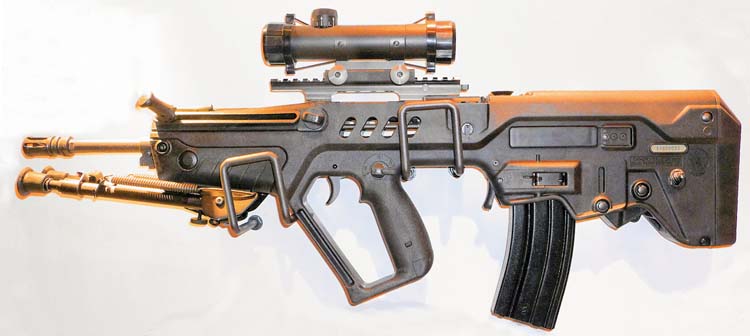
- The rifle should be effective out to the maximum feasible range for small-arms engagements; at least 800 meters. The definition of effectiveness to include hit probability, barrier penetration and rapid incapacitation of personnel.
- The rifle should be as compact as possible, so that it is handy for urban warfare and for carrying in cramped vehicles and helos.
- The rifle’s recoil should be light enough to facilitate training, rapid and accurate semiautomatic fire, and controllable burst fire.
- The rifle should be capable of maintaining a high rate of fire for several minutes.
- The LMG should use the same ammunition as the rifle, be belt-fed and be capable of accurate and sustained automatic fire out to at least 1,000 meters.
- The guns and their ammunition should be as light as they can be without compromising any of the above requirements. I will now consider the three elements – ammunition, guns and sights – to examine the implications of these requirements.
Ammunition
In this section I will be considering ammunition performance; essentially, ballistics. I don’t intend to consider advanced cartridge technologies such as the caseless-telescoped and plastic-cased-telescoped rounds being developed as a part of the U.S. Lightweight Small Arms Technologies programme. If one of these is eventually selected for production, it will bring the considerable benefits of a substantial weight reduction, but it won’t alter such matters as the choice of caliber, bullet weight and type, external and terminal ballistics.
To summarise a complex argument: it is both possible and desirable to develop one round which could replace both the 5.56mm and the 7.62mm in portable infantry guns. This would halve the number of different weapons and would also ensure that each weapon has a much wider range of capabilities. It would significantly reduce the weight and recoil compared with 7.62mm ammunition, while improving the range, barrier penetration and terminal effectiveness compared with 5.56mm.
If the ammunition is to be effective at long range, it must match the standard 7.62mm NATO ball round in its trajectory, retained energy and barrier penetration at 1,000 meters from the same length barrels. However, if it is to reduce the ammunition weight and recoil compared with 7.62mm, it must be smaller and less powerful. This conflict can be resolved by selecting a caliber intermediate between the 5.56mm and 7.62mm, with a low-drag bullet which will lose velocity (and therefore energy) more slowly than the 7.62mm ball. Other things being equal, low-drag bullets are heavier than usual, so to keep recoil in check need to be fired at a lower velocity. Muzzle energy will be lower than the 7.62mm (but appreciably higher than the 5.56mm) but the right specification of low-drag bullet will eventually catch up with and even surpass the 7.62mm at long range.
In practical terms, the smallest caliber likely to deliver a performance comparable with the 7.62mm is 6.5mm, while the largest which would enable recoil and weight to be kept in check is 7mm. Exactly which caliber proves to be the best compromise should be determined by more detailed analysis, comprehensive testing and preferably combat experience. Initial calculations indicate that a muzzle energy in the region of 1,800-1,900 ft/lbs will be required, compared with figures of around 1,250 ft/lbs for the 5.56mm and 2,500 ft/lbs for the 7.62mm. Experience of existing cartridges in this class indicates that the weight will be mid-way between the 5.56mm and 7.62mm, but the perceived recoil will be much closer to 5.56mm, thereby maintaining good controllability.
The U.S. Army’s ARDEC Small Caliber Munitions Technology Branch recently conducted an analysis of calibers for future infantry weapons, with the results emerging in March 2011. A wide range of criteria were examined including: penetration; terminal effectiveness; accuracy; initial, retained and striking energy; wind drift; stowed kills; and recoil. The existing 5.56mm and 7.62mm rounds were tested at various ranges in comparison with 6.5mm and 7mm, in all cases when loaded with similar lead-free bullets (copper or copper+steel – the latter representative of the M855A1). The conclusion of the study confirmed that calibers in the 6.5mm to 7.0mm range deliver the optimum characteristics for use in military small arms. This issue has since been followed up by a Joint Caliber Working Group sponsored by the TSWG Tactical Operations Support Subgroup.
Gun Design
The need for good long-range performance combined with a short overall length for handiness in urban fighting and in vehicles causes problems for traditional rifles, since the first requires a long barrel and the second a short one. A folding stock can resolve the carrying problem (where that is possible: which it isn’t with the M16 and M4, for instance, as the action extends into the stock) but doesn’t help in urban fighting when the stock must be extended to provide controllability.
One option is to have barrels of different lengths which can be changed depending on the circumstances, but that may not be convenient, particularly if the ranges keep changing during a patrol (for example, a section might be searching a village but then be attacked from long range as they leave). Another option is to select a compromise barrel length, but this will result in a gun which is longer than is desirable in urban fighting and which will have a reduced long-range performance – unless the power of the cartridge is increased to deliver the same performance from a shorter barrel, in which case the ammunition weight, recoil, muzzle flash and blast will be increased. The obvious solution to this dilemma is to adopt a bullpup configuration, with the action and magazine located at the back of the gun, behind the pistol grip.
The proposal of a bullpup is controversial since the U.S. Army has never used them, while the British Army has been put off them by the long and painful saga of the SA80, so requires some further justification.
There are three principal objections to a bullpup:
1. Poor ergonomics: the location of the action and magazine well to the rear of the pistol grip makes operating the controls and changing magazines more difficult. This is particularly an issue with the SA80.
2. Lack of ambidexterity: most bullpups (although not the SA80) can be converted to left-hand use, but that takes some time to achieve so can’t be done in the heat of battle. This means that users can’t switch shoulders to aim round the corner of a building, for instance, without being hit in the face by their own ejected cases.
3. Lack of ability to adjust the stock length to allow for the wearing of body armour: again, a particular problem with the SA80 which has quite a long stock.
Apart from these practical concerns, some users dislike the rearward weight balance of the bullpup and the proximity of the action to the firer’s head in case of a chamber explosion.
There are responses to all of these objections:
1. The ergonomics do not have to be as poor as the SA80’s: the latest version of the Israeli Tavor, for instance, has controls which match those of the M16 and M4 in location and operation, since it was designed to replace them.
2. There are various ways of achieving ambidexterity. The FN F2000 uses a forward ejection tube, which carries the spent cases to the front of the gun before they are expelled. The new Beretta ARX-160, although not a bullpup, has a mechanism which changes the case ejection side at the flick of a switch. The STK SAR-21 from Singapore has a simpler solution for emergency left-hand use: a large and effective case deflector.
3. An adjustable stock could be provided if the gun action behind the magazine were designed to be shorter: something which hasn’t happened so far since there has been no call for it. However, that should not be difficult to achieve in a new design.
Gun balance is, to a great extent, a matter of what you are used to. Some bullpup users prefer the rearwards weight balance, arguing that it is easier to hold one-handed or for extended periods, and makes the rifle quicker to change aim. What is undoubtedly true is that a bullpup is far more evenly balanced once an under-barrel grenade launcher, large electro-optical sights and other tactical kit (e.g. torches) start being added: a traditional rifle then becomes massively front-heavy.
The firer’s head can be shielded from the action by using a tough Kevlar cheek-piece, as with the STK SAR-21; this could be designed to flip quickly from one side to the other in conjunction with a switchable-side ejection system like the ARX-160’s.
It is worth emphasising the key argument in favour of the bullpup: the design reduces the overall gun length by some eight inches for the same barrel length, which is a huge reduction. This is not just an advantage in urban fighting; it also facilitates fitting a suppressor, which is increasingly popular to reduce muzzle blast and flash and make firers more difficult to locate (it also protects the firer from long-term hearing damage). With barrels of the same length, a bullpup with a suppressor will be about the same total length as a traditional rifle without one.
In addition, the adoption of a general-purpose intermediate round as proposed here would strengthen the case for the bullpup. At the moment, it is possible to argue that 5.56mm rifles can have short barrels because they are now principally seen as short-range weapons. On the other hand, 7.62mm rifles are being introduced for the long-range role and therefore don’t need to be very compact for urban warfare. However, a single general-purpose infantry rifle in a general-purpose caliber must be well suited to both urban fighting and the long-range role. As previously mentioned, this combination can be achieved with a modular traditional design with quick-change barrels of different lengths (as most recent designs offer), especially if the action design also allows the stock to be fully telescoped. However, the bullpup layout does not require any such changes, and it is effectively two existing weapons – a rifle and a carbine – in one.
One issue which often receives little attention is recoil control, which as already observed is important in a rifle in order to facilitate training, rapid and accurate semiautomatic fire and controllable automatic fire. In guns of similar type, recoil is largely a function of the gun weight and the cartridge power (specifically, the momentum – mass times velocity – as opposed to energy – mass times velocity squared). However, the gun action can also have a significant effect, with advantages being demonstrated by soft-recoil mechanisms or even opposed-piston types like the AK-107. The U.S. Army has recently been researching this and achieved reductions in the peak recoil force of up to 90% by using a counter-mass principle; but this would inevitably add weight. Controllability in automatic fire can also be enhanced simply by reducing the rate of fire. The very high cyclic rate common in modern 5.56mm small arms has little if any practical benefit and leads to more rapid ammunition exhaustion and barrel heating as well as greater cumulative recoil.
To achieve a large volume of automatic fire, as may be involved in fighting off a close-range attack, usually requires a heavier barrel to delay overheating. However, the U.S. HPAWA project (High Performance Alloys for Weapon Applications) aims to result in barrels which will withstand far heavier rates of sustained fire, so that MGs can be issued with only one barrel. Good progress has since been reported by ARDEC in the development of highly temperature-resistant cobalt alloys. If such alloys reach production, this should enable a standard rifle to offer volumes of fire comparable with an IAR without any increase in barrel weight. The problem of cook-off after an intense engagement could be addressed, if need be, by arranging for the gun to fire from an open bolt in automatic mode (although the USMC has not required this of their new IAR). In other words, we could replace three weapons (carbine, rifle and IAR) with one.
The design of the belt-fed LMG to accompany this rifle has not been discussed here, since the same design problems do not apply and existing designs could be adapted well enough to a new cartridge. The adoption of a general-purpose intermediate cartridge developing significantly less recoil than the 7.62mm would however obviously allow the weight of the gun to be reduced without compromising reliability, which with the significantly lighter ammunition would deliver a substantial reduction in the weight currently carried by GPMG gunners and ammunition carriers.
Sights
Rifle and MG sights are currently making great advances in capability. Variable magnification has been available on the specialist market for a very long time, and has now been joined by dual-magnification military sights, initially from Elcan (with 1-4x and 1.5-6x versions currently available), equipping the infantry with a sight suitable for both short and long-range use. The addition of electronics is bringing even more dramatic advances, most obviously in night-vision capability. In 2010, the U.S. military stated a requirement for a 1-4x day/night sight, merging thermal and light intensifying images, with a built-in rangefinder (and possibly a laser pointer), with a 3 lb (1.36 kg) weight, low power consumption and a price of $3-5,000. With this kind of technology, such issues as air pressure, weapon cant and the effects of firing up or down hill can also be taken into account in providing an aiming solution.
Even more remarkable is the LIDAR (Laser Identification Detection And Ranging) unit developed by the Israeli Soreq Nuclear Research Center. This works by firing a laser beam at the target, the reflection being captured by an array of photodiodes. Fluctuations in the signals received by the photodiodes are used to detect the direction and velocity of any cross wind, which can have a major effect on hit probability at long range. Something like this may well have an application in the DARPA One Shot next-generation sniper scope programme. The One Shot programme is intended to enable snipers to be on target with the first round, under crosswind conditions, up to the maximum effective range of the weapon: a target of 65% probability of a first-round hit at up to 1,500 meters has been set when using long-range sniper rifles.
What all of this means is that we are soon likely to see practical day/night variable magnification sights which can take into account all of the usual factors which affect bullet trajectory. All the soldier will have to do is to lase the target and the sights will automatically indicate the correct aiming mark to put the bullets into the target area.
Initially, such sights will be bulky, heavy and expensive and thereby restricted to snipers, but it is safe to predict that within the foreseeable future they will become smaller, lighter and eventually cheap enough for general issue. This is enormously important because it means that the main objection to providing rifles with a long-range capability – that most soldiers will never be well-enough trained to hit anything at such ranges – is removed. In conjunction with a long-barrelled standard rifle and long-range intermediate ammunition (and assuming a fundamentally accurate weapon and good-quality ammunition production), this also means that a separate DMR or sharpshooter rifle may no longer be required. Potentially we could therefore replace four existing guns (carbine, rifle, IAR, DMR) with one.
The same sights and ammunition will of course also transform the long-range effectiveness of the belt-fed LMG, although the sustained-fire capability of a rifle with an advanced-alloy barrel may mean that fewer MGs will be needed.
Conclusion
So we have reduced our two cartridges to one, and our six or eight different guns to two – the general-purpose infantry rifle and the belt-fed LMG – without any loss in capability. The practical and financial advantages of such a simplification would be huge, as would the boost to the capability of the infantry sections in whatever tactical circumstances may arise.
Various attempts have of course been made to introduce an intermediate round before, one of the first being the .276 Pedersen of the late 1920s. After exhaustive tests this was recommended for adoption by the U.S. Army and the British were also very interested, but it was cancelled principally for financial reasons. The modern equivalent is the 7×46 UIAC (Universal Infantry Assault Cartridge), an experimental round being developed by Cris Murray who was involved in the development of the 6.8mm Remington SPC.
All of the technologies which I have mentioned are either available now or are very likely to be available by the time the next generation of small arms has been developed.
If LSAT succeeds (and the plastic-cased telescoped version is currently looking promising), then a dramatic weight reduction can be added to the other advantages; it would mean that an LSAT intermediate round could weigh about the same as the current 5.56mm.
Now all we need is the people in the right places with the vision to see and drive towards what is possible, rather than simply going down the same old road because that’s what we’ve always done. It is time for small arms to leave the 20th century.
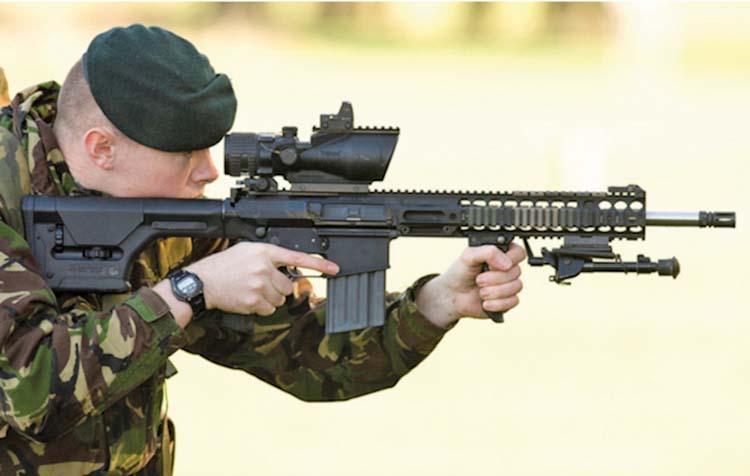
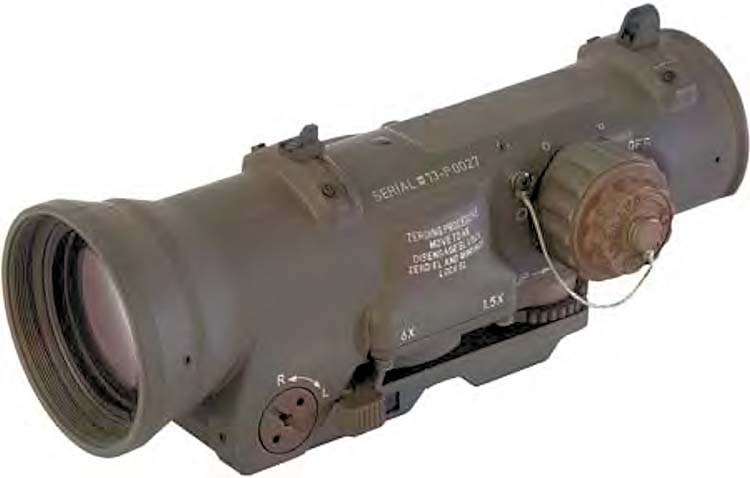

This article first appeared in Small Arms Review V16N1 (March 2012)












